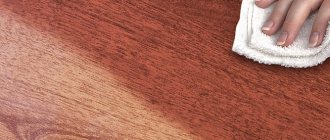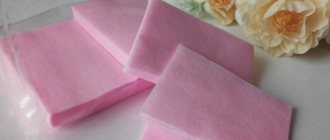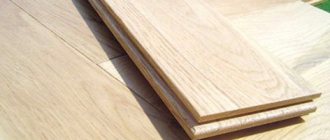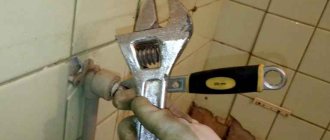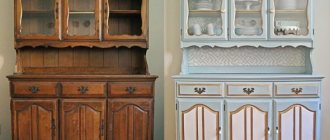Methods for removing old varnish from parquet
Classic types of parquet floors usually have a varnish protective coating. It makes wood floors look more attractive. Parquet varnish also acts as an additional protection for wood from the influence of physical and mechanical stress during operation. Parquet varnish has a special composition, which determines its stability and service life. Over time, the coating will fade, crack, and wear out. To return the floors to their original appearance, you will need to remove the old varnish from the parquet.
Preparation
Before removing the varnish from the parquet, you need to prepare the room for work. First you need to remove the furniture, cover windows, radiators and other non-removable interior parts with film. Use a vacuum cleaner to remove dirt and dust from the surface. And then begin to remove the protective layer.
It’s not enough to know how to remove old varnish from parquet; you also need to prepare equipment in advance. To work you will need:
- sander for the main part of the parquet;
- manual scraper for processing corners and hard-to-reach areas;
- sandpaper of different grain sizes;
- high-power construction or household vacuum cleaner.
There are three ways to remove varnish from wood:
- mechanical;
- thermal;
- chemical.
Consult an experienced specialist
+7 This email address is being protected from spambots. You must have JavaScript enabled to view it.
parquet work in Moscow and Moscow region from 150 rub/m2
Machine scraping method
Should I hire professional parquet floorers to solve the problem of restoring wooden floors? Not everyone has this opportunity. Often it all comes down to price. Local restoration can be carried out independently; it is enough to purchase the necessary equipment and fresh parquet chemicals.
Large-scale restoration of the varnish coating will require preliminary scraping or sanding. First you need to determine how many cycles the parquet product corresponds to. The more decorative the parquet, the fewer cycles it has. With a lamella thickness of 15 mm, the floor will withstand up to 5 cycles, 8 mm or less - no more than 2-3 times.
Sanding is carried out with a special electric machine that can be bought, which is very cumbersome, because it is rarely used at home. It is better to rent it from a company that provides such parquet repair services.
You can rent a sanding machine
Manual scraping method
There are different ways to remove old varnish by hand. Again, the choice of tool depends on the thickness of the wooden floor profile. The financial side of the issue is as important as taking into account the volume of planned work.
Regular sandpaper with a coarse abrasive will help remove the varnish. The event is a little dusty, but quite productive. Sandpaper allows you to simultaneously remove the old protective layer and level the surface of the floors.
Sandpaper is convenient to use for local reconstruction of varnish: stains, cracks, chips, abrasion. The cleaned surface is treated with acetone, which will remove small particles of scraped varnish. After which BF-6 glue is applied. The last stage is repeated wiping with solvent.
BF-6 glue is an alcohol solution of phenol-formaldehyde resin with polyvinyl butyral, softeners and plasticizers. Not subject to rotting and corrosion, resistant to the influence of the atmosphere, oils, gasoline, kerosene, mold, water and acids, less resistant to alkalis, alcohols, and solvents.
Hand scrapers are sold in almost every hardware store. The tool is available in a variety of scraper widths and handle lengths. Note that the work of hand scrapers with a short handle is more tedious, but cleaning the parquet from old varnish will be better.
You can also remove the varnish with a hand tool and sandpaper.
This process is labor-intensive. The work requires accuracy and attention, since when removing varnish, the top layer of wood is cut off along the wood fibers. Be sure to pay attention to the nature of the cut in the manufactured profile:
- radial (annual rings are located perpendicular to the surface of the bar);
- tangential (the plane of the cut runs tangent to the annual layer of the trunk);
- mixed.
Do-it-yourself cleaning of wooden floors from old varnish is only half of the restoration work. Afterwards you will need to apply a primer (this will ensure better adhesion of the varnish layer) and sand the surface of the wood. At the end, the floors are re-varnished.
Description of various methods
Removing the varnish coating involves direct action on the film. This may be mechanical force, the use of chemically active compounds or thermal pressure. Each option has its own characteristics.
Mechanical impact
The easiest way to remove varnish from wood or other surfaces is to peel off the film by physical force. To do this, use a tool with stiff bristles or a metal blade.
Manual scraper for mechanical removal of paintwork materials Source vseinstrumenti.ru
Thin-layer coatings can also be abraded with varying degrees of grit abrasive. As an alternative to ready-made devices, blades, knives, and glass can be used. The latter, however, wears off very quickly. In any case, you need to protect your hands from cuts.
In addition to hand tools, there are analogs for use with electrical equipment. Thus, an analogue of a cord brush are attachments with metal bristles, which can be installed in a chuck for a drill and screwdriver. With an angle grinder, flap discs with bristles along the edge and emery or grinding wheels are used. The latter are fixed on a special platform called a plate.
Another solution to removing varnish from a wooden surface is a specialized tool. This is a sanding machine. There are three types:
- vibration - a rectangular platform with a small amplitude makes reciprocating movements in the longitudinal direction;
Vibrating grinder Source gidpokraske.ru
- tape - here the sandpaper is represented by a closed narrow strip, which the mechanism rotates in one direction in a straight line relative to the tool;
- eccentric - the mechanism transmits translational and reciprocating circular movements to the platform.
The high efficiency of each of the tools is the main advantage. But during the grinding and polishing process, a large amount of dust is generated. This problem can only be solved with models that can function in conjunction with a vacuum cleaner. Practice shows that a simple dust collector slightly improves the situation.
The listed solutions have both advantages and disadvantages. On the one hand, there is no need to breathe toxic substances, there is no risk of changing the color of the working base, and you can control the entire process. But on the other hand, in addition to the dust generated, there is a risk of mechanical damage to the wood structure, fabric fibers and scratches on a smooth surface.
See also: Catalog of companies that specialize in finishing materials and related work
Chemical removal
A wide range of products are available on the construction market for removing varnish from wooden surfaces.
Special remover for old paint and varnish Source voil.ru
These can be liquid removers, gel-like compositions, solvents and powders. Let's look at the features of each of them:
- Liquid . The product is used provided that the coating consists of a maximum of three layers. This is justified by the fact that such varnish remover contains solvents that evaporate quickly. That is, chemical reagents can affect the coating for an extremely short period of time. Also, due to the consistency, there is a limitation in the form of vertical bases. Here the wash just runs off.
- Gel and paste . Such compositions can have a chemical effect on the base for a long time. Therefore, they are relevant for removing multi-layer coatings, including vertical ones.
- Powder . This option is more often used in the case of large-scale work, which is justified by convenience and long shelf life. Before use, the material must be dissolved in water to obtain a thick paste-like mass.
Removing coating after chemical exposure Source sdelai-lestnicu.ru
Solvent can also be considered one of the means for removing varnish from wooden surfaces. But here it is important to take into account the fact that the composition is capable of chemically acting on the coating only until it has dried. A spray works a little better, which turns into foam at the exit. This mass is not as fluid as liquids. But the action time is inferior to gels and pastes.
Thermal impact
A relatively universal solution for how to clean varnish from a wooden surface can be considered thermal action. By heating the base, the bond between it and the coating weakens. The film first cracks, then softens. Therefore, it can be easily removed with a regular spatula.
Unusual scraping tools
You can completely clean parquet floors of old varnish with your own hands, or rather, with your own feet. To do this, find a pair of flat-soled shoes among your shoes and glue sandpaper to the bottom. The first “pass” must be made with abrasive No. 40 (primary grinding), the second - with abrasive No. 80 (finishing).
Shuffling your feet is much easier than manually operating on your knees. And the procedure itself will be more accurate.
Some folk craftsmen, among other tools, can find a sample of a handmade scraper, made with their own hands from improvised materials. Actually, other tools are used, specially tailored to the task. For example, an iron rod of a plane with a hooked tip.
The sharp end must be given the required shape:
- the metal is heated to red;
- cools slightly in natural conditions;
- clamped in a vice with a pipe;
- the end is bent along the pipe with light, even blows of the hammer;
- the angle is adjusted;
- heats up;
- The outer side of the bend is sharpened.
How to remove varnish from a parquet board?
I’ll share my experience in stripping wood with different tools and, since the topic is similar, I’ll ask my own questions...
About 9 years ago I was renovating old wooden windows at my parents’ house - I stripped them down to the wood from numerous layers of paint that had accumulated over 30 years. I experimented as best I could, using the entire arsenal that I had at that moment: a drill with a circle attachment (a round sanding disc), a hair dryer and some kind of chemical filth. In addition to a hairdryer and chemicals, respectively, I used a couple of metal spatulas (hard and soft), and hand-sanded sandpaper on small blocks. I didn't like chemistry at all. Besides the fact that it stank terribly (even though I ventilated it while working in the opening of an open window, I still inhaled it, bless me. And I didn’t appreciate it somehow. Maybe I did something wrong. The hairdryer also didn’t impress me - the paint under its heat it bubbled and began to spread across the wood. As a result, some of it was scraped off, but what remained, on the contrary, was deeply absorbed into the wood. Moreover, when using chemicals and a hair dryer, when peeling with a spatula, it constantly cut into I knocked out huge chips of wood, then beveled the corners, then drove these chips into my hands.. As a result, I did the main work with a drill with an attachment. I used a round attachment with Velcro, to which I changed the sanding wheels. Krugov, I remember, wore out immeasurably. But , in principle, it wasn’t very expensive in terms of money. In hard-to-reach places and corners, a simple piece of sandpaper and a block were of help. I did all this, I remember, for a very long time. It’s still disgusting to remember the impressions, because there was very little pleasant there But, however, I now have such experience in my practice.
Last summer I practiced stripping pieces of wood using a flap wheel on an angle grinder. I cleaned the fences of old peeling paint. An angle grinder, of course, is a beast! It blows everything away with a bang! But you can completely forget about a flat surface. Yam dug these, wow! Well, in this case, the evenness of the surface was not critical to me. There is even something interesting in the resulting pits. However, I think it’s worth warning about pits when grinding angle grinders.
I recently acquired a FSM on my farm. So far, I'm doing a great job of sharpening the non-converging corners of the trim. Next summer I am planning a test for her in the form of cleaning the old wooden plank floor on the porch. I'm curious what will come of this. True, there are questions here. The floor was covered with several layers of parquet varnish, which today peels off in places like wood, but in others is still holding on. Is it worth going over, for example, with a grinder with a metal brush, before starting to sand the PSM, to peel off as much of the varnish as possible, or will this be of no use and will only spoil the structure of the wood?
Instead of an afterword
Any attempts to manually remove varnish from a parquet floor require maximum effort, care and accuracy. The difficulty lies in the fact that you need to constantly control the cutting force of the parquet and monitor the sharpness of the tool. Dust and dirt cannot be avoided. Therefore, it does not hurt to use personal protective equipment: a respiratory mask, gloves, goggles. At the same time, restoring wooden floor coverings yourself is quite possible and much cheaper than the services of parquet specialists.
Source
Operating Instructions
When choosing what and how to remove varnish from wood, you need to familiarize yourself with the rules of the event in advance. This way the process will be completed with the highest quality possible and without harm to human health. Let's consider the instructions and recommendations of specialists regarding each of the techniques.
Cord brush attachment for a screwdriver Source onlinetrade.ru
Mechanical removal technology
The first thing to do is determine the thickness of the coating layer to be removed. This can be all of the varnish or just part of it. The second option is provided by the base preparation technology if subsequent varnishing with a material similar in characteristics is planned.
Next, select a tool. It is easier to remove the top layers with coarse cord brushes and coarse-grain abrasives. To prevent damage to the base, you need to gradually reduce the degree of aggressiveness of the physical impact. The process is completed by sanding the working area with fine-grained sandpaper. After removing dust and dirt, you can begin further finishing work.
Chemical Removal Technology
The process of removing varnish from wood consists of several stages. But before this, it is important to protect surrounding objects, hands, respiratory organs and eyes from chemical exposure.
Working with chemical compounds in rubber gloves Source berkem.ru
How to remove varnish from parquet yourself
Parquet flooring is almost always coated with a special protective varnish. It not only decorates the floors, but also provides additional protection from moisture, dust and damage.
Its consumer qualities are very high - such a varnish will protect wood from the consequences of physical and mechanical influences, giving it an elegant and attractive look for many years.
However, over time, even such high-quality materials can lose their former beauty and freshness - they fade, wear out, and crack.
In order for the floor to return to its original appearance, the old varnish must be removed.
Machine sanding of parquet
There is not always a budget and the ability to attract professional craftsmen for the work.
The cost of their services is quite high, so not everyone can afford to invite specialists to restore old parquet.
However, there is an alternative to remove surface defects. You can do all the work yourself; in this case, you will only have to pay for the purchase or rental (a more profitable option) of equipment and the purchase of modern parquet chemicals.
For a full-scale renovation of parquet, sanding (or sanding) is simply necessary.
At this stage, the old varnish is removed and a thin layer of wood can be removed.
Due to this option, when it is possible to remove inaccuracies, the floor is leveled, because during operation the wooden floor can be slightly deformed.
The number of such sandings in order to remove defects that the parquet can withstand before it needs to be completely replaced depends on the thickness of the boards. For example, a 1.5-centimeter lamella can be scraped up to 5 times, and an 8-mm lamella - no more than three.
You can remove it using a special electrical device.
How to remove paint from parquet using chemicals
Removing varnish with chemicals is a dangerous procedure. If you choose the wrong composition or violate the technology, you can damage the parquet. Construction stores sell ready-made removers in the form of powders, gels, and solvents. Chemical liquid compositions work where no more than three layers of varnish are applied. For multi-layer coatings, a gel composition will be required.
If you need to remove varnish from the floor in a large room, it is convenient to use powders. It is diluted with water, bringing it to a paste.
When working with chemicals, you need to wear a protective suit, goggles and a respirator. The remover is applied with a brush. The holding time of the composition is three to four hours. The soft varnish is removed with a metal spatula. Remains of varnish can be removed with water and vinegar mixed in a ratio of 5 to 1.
Removing old varnish is only the initial stage of restoration. After this, you will also need to prime and sand the floor. The final stage is varnishing.
Manual processing of parquet
There are several techniques for manually processing flooring. Tools are selected in accordance with the thickness of the parquet board.
The amount of work and the material side of the issue are also important.
You can purchase a hand scraper at a hardware store. It is worth noting that materials with a short handle require more labor compared to scrapers with a long handle, but they also remove old varnish better.
A rather dusty but effective method is to remove the varnish with sandpaper.
This is very convenient in cases where you need to clean any fragment of varnish: if a stain has appeared, chipped, cracked, or the varnish layer has worn through.
An additional advantage is the fact that during cleaning, sandpaper simultaneously levels the surface of the wood.
When the varnish has been completely removed, the floor is wiped with acetone - it will remove the smallest particles of coating that go unnoticed.
At the next stage, after the defects have been removed, the BF-6 adhesive composition is applied. It is a solution of phenol-formaldehyde resin and polyvinyl butyral with alcohol and modifying additives.
This product will protect the surface from putrefactive processes, mold formation, negative effects of the external environment, the effects of oils, gasoline, kerosene and water, and the effects of acids. Its resistance to alkaline and alcohol exposure is slightly weaker.
The final stage is wiping the surface with a solvent.
During work, it is necessary to take into account the location of the wood fibers, since a thin layer of wood is cut off during cleaning. To ensure that the surface is not damaged, you need to move along the fibers.
Their position may be different:
- if the annual rings are located perpendicular to the surface of the lamella, this position is called radial;
- the cut is made tangentially to the annual layer of the trunk - this is a tangential cut;
- mixed cut contains features of the previous two.
How to remove old varnish from parquet using a thermal method
The hot method involves heating the protective layer to the melting point. The varnish softens, and then it can be removed with a metal spatula. You need to wear gloves and the room should be well ventilated.
You can heat the floor with a gasoline or gas lamp.
They are sold in hardware stores and are inexpensive. You need to work very carefully, as there is a risk of causing a fire. It is safer to work with a hair dryer. It is necessary to set the desired temperature and heat the surface evenly. It is convenient to remove the melted varnish with a metal spatula.
"Folk" instruments
You can remove old varnish not only with your own hands, but also with your feet. Despite the funny sound, this method is quite popular due to its simplicity - after all, you only need to walk, shuffling with the soles of your shoes.
To obtain the expected result, the sole must be flat. Sandpaper (40 abrasive) is glued onto it and the entire floor is thoroughly “scraped.”
Then the sandpaper is changed to 80-grit and passed over the parquet again. At this stage, its surface is polished.
Some people use homemade cycles made from tools available around the house.
For example, a plane with a hooked edge.
To make such a cycle, you need to heat the sharp metal end of the tool red-hot, cool it a little and clamp it in a vice with a pipe.
Lightly tap the heated metal with a hammer, giving it a rounded shape along the pipe. Adjust the angle if necessary, reheat and sharpen the outer side of the resulting bend.
It is more convenient to use a homemade scrubber. The procedure for its manufacture is similar to the previous one.
Such a tool can often be found in the hands of sailors, ship repairers and shipbuilders - they can easily remove rust, deep dirt and remnants of old paintwork.
Methods for removing varnish from parquet
Of course, parquet is the most wear-resistant floor surface finish, especially when a layer of high-quality varnish is applied on top. However, no coverage is immune to the process of obsolescence. Experts do not indicate a specific period when the old varnish needs to be replaced with a new one; everything here is individual.
Removing varnish from parquet flooring
But, of course, there are factors that influence the duration of this period, namely:
- it is necessary to take into account in which room the parquet finish was installed and for what purposes it is used;
- whether all recommendations specified in the instructions for the materials were followed during the process of laying parquet and coating it with a varnish substance;
- Is the surface properly cared for (with gentle detergents, a cloth or a household sponge);
- whether the type of varnish coating was initially chosen correctly.
In most cases, varnish replacement is necessary after using parquet for 10–15 years. If the surface is severely damaged by heaters or animals in the area, you will need to find out how to remove the varnish from the parquet and apply a new one much earlier.
Sanding parquet with a drum machine
Floors in rooms where a large number of people pass daily (most often these are government institutions) are subject to annual renewal of the varnish component on the parquet.
How to remove varnish from parquet manually
Many users ask how to remove nail polish without equipment at home. You can manually remove the old coating, but it will take more time. Again, you can’t do without a tool at all.
You can remove the paint with simple coarse sandpaper. The work is dusty, but brings good results. You can additionally level the base with sandpaper.
It will be problematic and time-consuming to process the entire area of the room, but sandpaper is perfect for corners, niches, removing local stains or areas under radiators. After sanding the floor, the work is not finished. You need to apply BF-6 glue to the surface, and then use a solvent.
These methods benefit from the absence of chemicals that negatively affect health. When cleaning, the structure of the tree is not disturbed. After sanding, the parquet will be like new.
Choosing varnish for parquet
Criterias of choice
When initially deciding on a varnish for a parquet surface, you need to understand what kind of load it must withstand, so that you don’t have to remove the varnish from the parquet too soon. Today, the construction market is overflowing with various varnish substances that differ from each other in technological parameters, chemical components, and application options.
Basically, consumers pay attention to the following main varnish-containing substances:
- water-free polyurethane;
- water soluble;
- acid-curing;
- primers;
- manufactured on oil resins.
Some of them are glossy and reflect approximately 70–100% of light, others are characterized by semi-gloss (30–70% of light). Semi-matte and matte are dull and discreet, hiding blemishes and surface defects. What does shine depend on? On the degree of presence of filler in the material, which scatters light.
Types of varnishes for parquet
As for abrasion resistance, the highest quality in this regard are polyurethane and waterless varnishes. Acrylic, on the contrary, is not durable, but at the same time it withstands the influence of chemical compounds from the outside.
Technical features of the event
Almost all types of varnishes form a film. The compositions differ in the principle of action and in the thickness of the coating formed. Therefore, there is no universal way to remove it.
The choice of solution for how to remove varnish from a wooden surface depends on the following criteria:
- density and coating layer;
- chemical composition of the finish;
- the nature of the working foundation.
The last point is especially important. To work with fabrics, glass or parquet, you need to use different techniques. Let's take a closer look at each of them.
Removing varnish from parquet
Required Tools
Finally, you have decided which varnish is best to cover the parquet after removing the old layer of material. In order to clean parquet from varnish, you must have the following list of products and tools:
- putty mixture;
- grinding machine;
- vacuum cleaner.
Step by step guide
When repairing parquet, it is important to replace the varnish in a timely manner, preventing it from completely abrading and trampled marks appearing on the surface.
Before removing the varnish from the parquet, you need to sand the surface. If the damage is deep and clearly visible, in addition to the varnish substance, an additional 0.5 mm of wood is removed, but no more.
Borrow a grinding machine from your friends that will handle this procedure as gently and accurately as possible. In this case, the room should be well ventilated and ventilated - there will be a lot of dust. You can turn on the vacuum cleaner in advance, which will also remove a certain part of dust particles from the air. Remember to protect your lungs and eyes with protective equipment.
Before starting the sanding procedure, thoroughly cover all the cracks with putty, wipe the floor with a slightly damp cloth, thus clearing it of dirt. Now start sanding. This work is painstaking and cannot be rushed. A small household sander may require several days of sanding on the floor.
It is necessary to prime the surface before applying varnish
Experts point out that if the parquet is too damaged, it must be sanded, which is carried out using a drum machine. In everyday life, this procedure looks somewhat different. First, an abrasive is taken to remove the paint, then all visible gaps are covered with putty mixture. After that, a medium-hard abrasive comes into play, which negates the remaining rough scratches. The final stage is cleaning the parquet with a fine abrasive. This floor is covered with at least 2 layers of varnish.
How to remove varnish from parquet mechanically
Removing varnish mechanically involves removing the top decorative coating using abrasive materials and tools.
To do this you will need:
- sandpaper;
- Sander;
- cycle.
You need to start removing varnish by sanding. It is necessary to remove at least 1 mm of the top layer. First you need sanding paper with large grains, which is inserted into the machine. When working with a grinder, you need to wear a protective suit and a respirator to avoid breathing harmful dust.
If the parquet is laid in a herringbone pattern, you need to drive in the direction of the pattern. If parquet flooring is laid in a deck manner, stripping is carried out from corner to corner of the room. Otherwise, the sander will tear the wood, damaging the structure.
Along the walls, cleaning is done with a hand scraper or angle grinder. The second and third times, cleaning is done with medium- and fine-grained sandpaper. After sanding, dust and dirt are removed with a construction vacuum cleaner.
